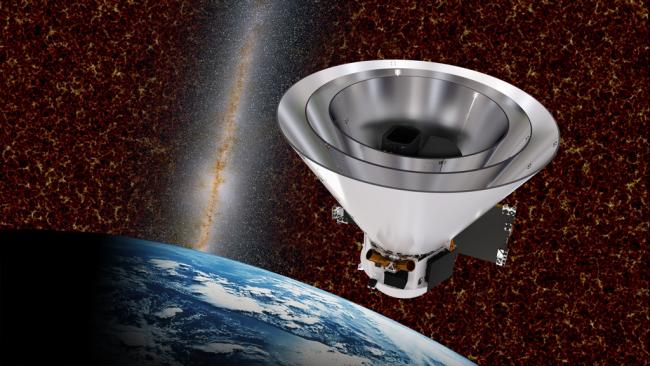
This artist's impression of SPHEREx shows the spacecraft as it will appear when in low-Earth orbit. During its 27-month nominal mission, SPHEREx will conduct four all-sky surveys to study the early history of the cosmos and search for interstellar molecules such as water and other compounds thought to be precursors of life as we know it.
Credit: NASA/JPL
A new NASA mission with major roles from scientists at the Center for Astrophysics | Harvard & Smithsonian (CfA) will help answer questions about why the large scale structure of the Universe looks the way it does today, how galaxies form and evolve, and what are the abundances of water and other key ingredients for life in our Galaxy.
SPHEREx (Spectro-Photometer for the History of the Universe, Epoch of Reionization, and Ices Explorer) will identify specific atoms and molecules in millions of objects across space using their unique signatures in optical and infrared spectra, which show how their light depends on wavelength.
After its launch into space on March 11, 2025 from the Vandenberg Space Force Base in California, SPHEREx will survey the entire sky four times over its 25-month mission. Astronomers will be able to combine SPHEREx’s ability to scan large sections of the sky quickly with more targeted studies from ground-based telescopes and others in space like NASA’s James Webb Space Telescope (JWST).
The CfA will lead the investigation into the abundances and distributions of molecules that are vital for life. Specifically, SPHEREx will conduct a survey along almost 10 million lines of sight in the Milky Way and the Magellanic Clouds, neighboring galaxies to our own. This survey will reveal crucial life-enabling molecules like water (H2O), carbon monoxide (CO), and carbon dioxide (CO2) in their icy states on the surfaces of interstellar dust grains.
These data will enable CfA scientists to evaluate the ice content in each direction and will help to trace the evolution of these ices as they transition from molecular clouds to planet-forming disks and, ultimately, to newly forming planets. JWST can follow up the most interesting targets identified by SPHEREx, making the two facilities a particularly powerful combination for studying how Solar System planets as well as planets around other stars get their key ingredients for life.
The CfA SPHEREx team is led by Dr. Gary Melnick and includes Drs. Matthew Ashby, Joseph Hora, and Volker Tolls, who are joined by visiting scientist, Dr. Jaeyeong Kim, from the Korean Astronomy and Space Science Institute.
SPHEREx’s data will be freely available to scientists around the world, providing new information about hundreds of millions of cosmic objects. More about SPHEREx at the CfA can be found at https://www.cfa.harvard.edu/facilities-technology/telescopes-instruments/spherex
Related News
Runaway Stars Reveal Hidden Black Hole In Milky Way’s Nearest Neighbor
CfA Celebrates 25 Years with the Chandra X-ray Observatory
CfA Astronomers Help Find Most Distant Galaxy Using James Webb Space Telescope
Unexpectedly Massive Black Holes Dominate Small Galaxies in the Distant Universe
Distant Stars Spotted for the First Time in the Vast Magellanic Stream
CfA Scientists Help Reach New Milestone in Quest for Distant Galaxies
Astrophysicists Hunt for Second-Closest Supermassive Black Hole
The Tilt in our Stars: The Shape of the Milky Way's Halo of Stars is Realized
JWST Draws Back Curtain on Universe's Early Galaxies
Dozens of Newly Discovered Gravitational Lenses Could Reveal Ancient Galaxies and the Nature of Dark Matter
Projects
2MASS Redshift Survey
AstroAI
Dark Energy Spectroscopic Instrument (DESI)
GMACS
For Scientists